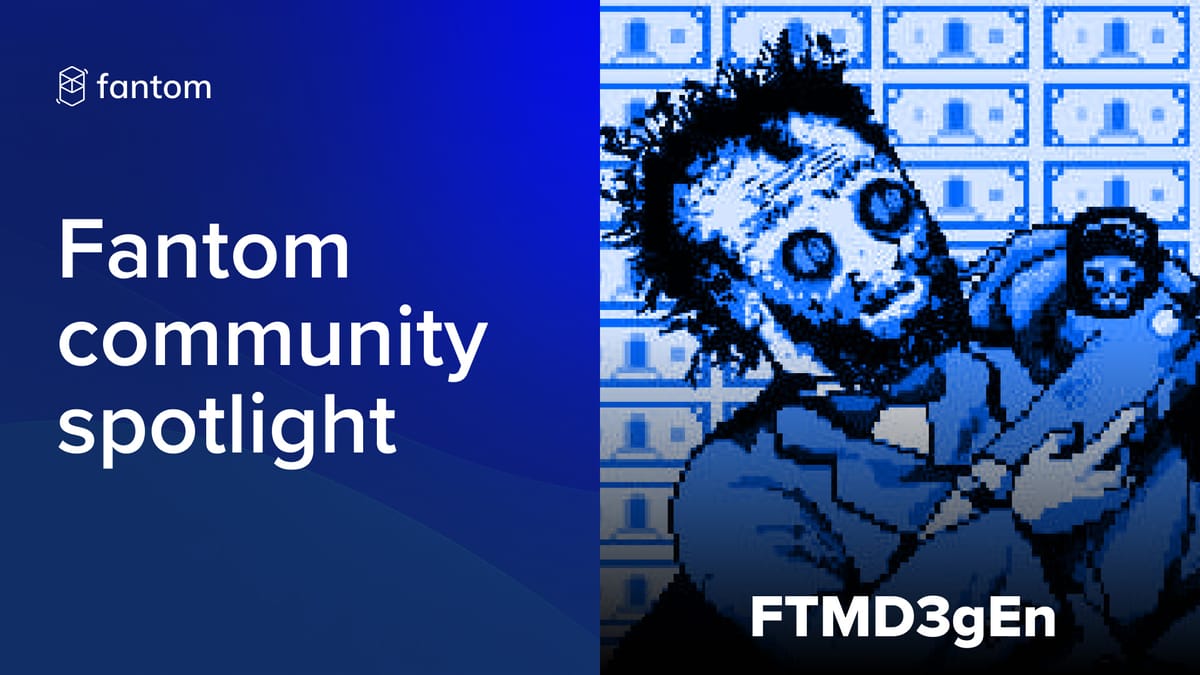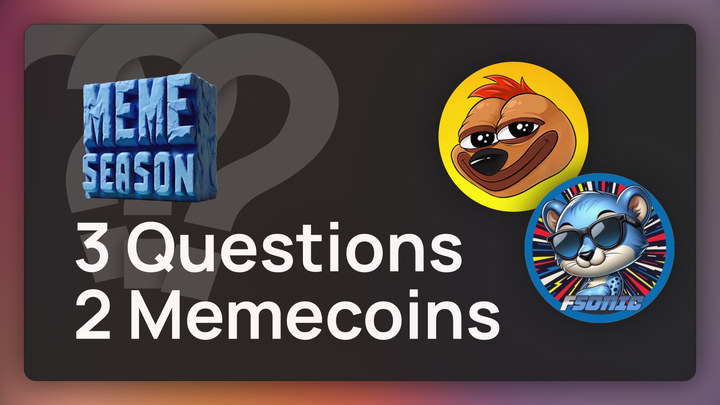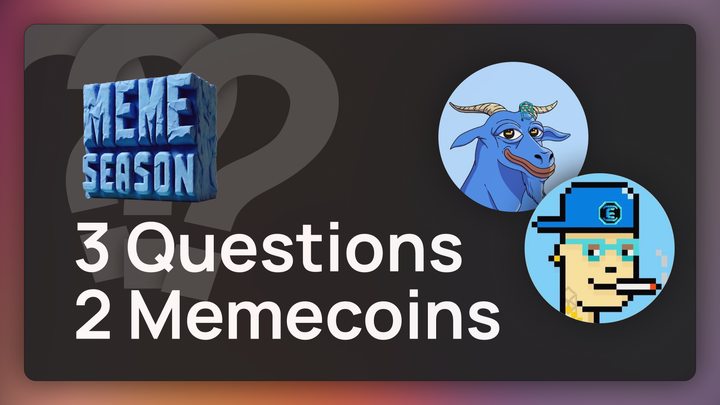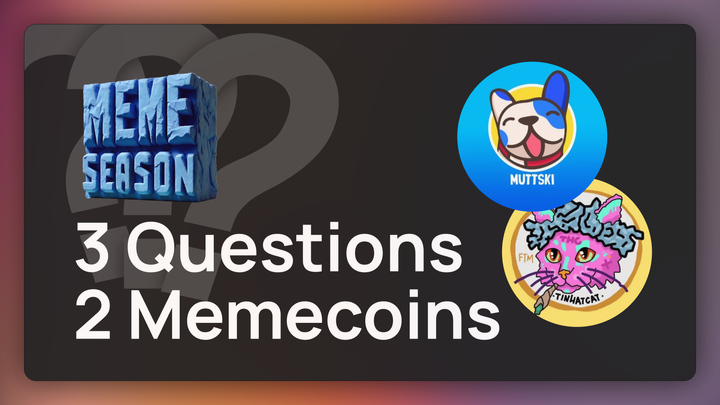Fantom Community Spotlight – FTMD3gEn

Once a stranger in a Discord server and now the Operations Manager for SpiritSwap, FTMD3gEn shares with us his relentless journey into crypto, the importance of civil governance, and how we can build better when we choose to work together.
The state of global financial markets and the need for financial sovereignty drove him toward the world of blockchain technology, but choosing where to start his Fantom journey came down to finding the right community.
How did you first get into crypto?
In 2009, I came across Satoshi’s Bitcoin White Paper while browsing Reddit.
At first, I did try to figure out how it worked, but there wasn’t enough information at the time. Back then it was just a string of code, and there were no BTC wallets to speak of.
I even came across the original BTC faucet but didn’t know how to use it.
Like most people who heard of it that early, I forgot about BTC.
Over the following years, the concept resurfaced its head in the form of a mention in the news or in a publication.
Fast forward to 2017, and I was leading a digital analytics team for a marketing company. By then, it was no longer possible for me to ignore crypto. That’s when I took the leap.
What convinced you to take the leap?
I view crypto as a catalyst in separating the state from finance. That’s a pertinent topic at this time; we’re going to see bad inflation happening over the next couple of years. Throw in a global pandemic, and we’re adding fuel to the fire.
My main motivator in investing in crypto was using it as a hedge against what I saw as the impending global financial crash.
Removing the need to have to trust a central party with my financial transactions was important to me, so it immediately resonated when I first came across the concept of a decentralized exchange.
While I was beginning to explore these concepts, I put together an investment group with some buddies, and they came across a project called Constellation DAG. That’s where I first heard about directed acyclic graphs. In researching other DAG protocols, I came across Fantom.
At the time, there was no DeFi infrastructure on Fantom, but we did have the Fantom Wallet. That was the first time I saw a new kind of capital efficiency unavailable in traditional finance: you could stake Fantom and use that to mint FUSD to use elsewhere.
How did you start getting actively involved in the Fantom ecosystem?
When Spookyswap launched, the moment we’d all been waiting for had arrived: DeFi had finally landed on Fantom. It wasn’t until a few days later, when I was browsing the Fantom Foundation Discord, that I noticed a developer named Rob talking about launching another DEX. His DEX would eventually come to be known as SpiritSwap.
Initially, I chose what DEX to use based on the community: where did I most want to spend my time learning about the space?
SpiritSwap’s community was extremely friendly and welcoming to me, so I went there.
I started by helping out as a volunteer, and I eventually got offered a moderator position. Then I went from moderator to admin, and at that point I was basically working two jobs: my 9-5 job during the day, and SpiritSwap at night.
I was wearing a lot of hats for SpiritSwap: writing medium articles, doing beta testing, and everything in between. The team eventually offered me a full-time job. I’ve been the Operations Manager ever since.
How do you build a strong team?
At SpiritSwap, our skill sets are well balanced and diversified. Most of the team comes from working in big tech, so we’ve got people with a strong technical background.
That being said, a strong technical background isn’t synonymous with having a solid grasp of DeFi fundamentals, so we’ve also got team members that are well-versed in that regard and help ensure we are strategic in the modeling we implement across our protocol as a whole.
Now that we’ve assembled the team, we’re heads-down building with the sole mission of contributing as much value as we can to the ecosystem.
Building in DeFi isn’t always sexy. A lot of it consists of throwing stuff at the wall and seeing what sticks, because that’s the only way we can push DeFi to its limits and see what we can achieve.
As long as we continue building products that empower people to control their financial outlook and opportunities in life, I want to be a part of that.
Where are there opportunities for newcomers to get involved?
From a protocol perspective, I’d like to see more teams adopting Fantom for use cases outside of DeFi.
A lot of “real world” applications are rife for disruption. An obvious example of this is supply chain distribution and industrial markets. Or authentication for the distribution of global pharmaceuticals.
For individuals coming in that are looking to contribute to the protocols that are already building on Fantom: do some soul-searching, and then research protocols that you feel align with your moral compass and with your fundamental goals.
Then jump into the deep end of the pool.
Join the project’s Discord server, get to know the mods, the devs, and the community, and look for where improvements can be made that you can contribute to with your existing skill set, whatever that may be.
Meritocracy is king in the Fantom ecosystem; if you provide something of value, good things will come your way.
What is the relationship between trust and anonymity?
I understand why some contributors and builders might want to be anonymous in the space. From a security perspective, they may want to protect themselves from punitive governments or other bad actors who might benefit from having access to their identity.If teams choose to be anonymous, look at their audits and make sure they’re done by a respectable firm. Look at the previous audits from whatever firm has audited them. Have there been previous exploits of contracts that they’ve audited? If so, did they adjust their processes to make sure the exploit is not repeated?If the code is a fork of another protocol, take the time to see how much of the code has been customized or changed, and whether that portion of the code has been audited.Even then, due diligence is not a silver bullet.
Have an understanding of your risk appetite: how much are you prepared to risk, and does the potential upside outweigh the risk?
Look at the fundamentals, and don’t rely just on technical analysis. If what the project is going to develop has a clear addressable market and has a clear value proposition, that might be a better indicator in your decision-making process than any technical analysis you could chart out.
How can we, as a community, work together to foster continued growth on Fantom?
Let’s ensure we’re harboring a positive environment for our developers and for the community.
Fantom revolves around its community, and we need to work together to make it clear that this is a safe place to ask questions, to learn from each other, and to grow.
A lot of Fantom protocols are already heading towards a civil governance model, which means adopting a DAO model or some form of on-chain governance.
With any kind of civil governance, you need to make sure you have a well-informed community so they’re making educated decisions. And a lot of that falls on the protocols themselves.
A lot of this critically important work is currently being carried out by teams such as FTMAlerts: they’re breaking down complicated protocols and mechanics to facilitate newcomers’ onboarding process, and they’re empowering investors to be able to weed out projects with no fundamentals or unsubstantiated narratives.
In terms of attracting competitive builders with integrity, the Fantom Foundation’s Incentive Rewards Program is a great first step. This incentive model has already driven builders to come and build on Fantom, and I wouldn’t be surprised to see other L1 blockchains adopt this model as well.
Rather than ostracizing newcomers or taking a “war narrative” approach, reach out with an olive branch and find ways to collaborate with them.
Where does governance fit into all of this?
Community is the glue to all of this. Together we stand, and divided we fall.
Governance and decentralization needs to be done gradually and thought out carefully. As with any form of civil governance—even in “real life”—we’ve seen it doesn’t always end well.
Not everybody is well-informed, and some people just don’t care about the bigger picture.
But when we make decisions on behalf of the protocols we invest in, we need to be well informed. This means being comfortable asking questions, and knowing there is no such thing as a stupid question in the search for clarity.
Being able to break down and understand varying perspectives is a good start, and then actually engaging with the community in discussing ideas is the next step.
Again, the onus is on each protocol to establish strong chains of communication to empower their community.
Just as with any form of politics, there’s no perfect solution to governance; it comes down to what your moral perspectives and goals are.
Why should individual investors get involved in governance?
Ultimately, governance determines policy and policy determines the outlook of a protocol. If you’re making the right decisions for that protocol and the greater community, you’re protecting your own investment.
This is why it’s crucial that protocols develop communities that think critically about the fundamentals of debate and objectivity. Establishing a strong foundation means fostering a community that understands policy, debates it, and learns from its past mistakes.
How might a project build an informed and engaged community from day one?
For new projects coming on, it would be very interesting to launch DAO-first.
From the inception of the protocol, you’d build a well informed community because the people who join have like minded goals, and you can establish strong chains of communication from the start.
You’d also weed out mercenary capital, because people won’t join a DAO-oriented protocol if they’re not interested in shaping policy and the discussions that ultimately determine the trajectory of the protocol.
PhantomDAO is an interesting project with a strong governance model that other projects could learn a lot from. They’ve done a lot of research on what projects have done well and where they’ve made mistakes from a policy and community perspective, and they’ve taken these learnings and implemented them, incorporating them all the way down to their tokenomics.
What Fantom projects are on your radar right now?
veDAO
Despite all the controversy, I want to see where this experiment goes. They’ve attracted a lot of liquidity to the Fantom ecosystem, and I’d like to see how much of that liquidity sticks around and gets put to productive use.
I want to reiterate that SpiritSwap has no affiliation with veDAO apart from one of our team being on their multi-sig.
Although their arrival to Fantom may have been perceived as disruptive and even sowed some internal division, I’d like to see us all come together and move past this.
I hope native Fantom protocols will accept their presence here and start to work together; our collective focus always has been and should continue to be building safe and effective products for the wider Fantom community as a whole.
QiDAO and Market XYZ
Although collateral-backed stable coins such as MAI come with an element of risk, I’m fascinated by the opportunities they offer for investors who may want to tap into a new paradigm of capital efficiency.
There are many moving parts to these protocols, and they should only be used by investors with a strong fundamental understanding of how the underlying mechanisms work.
MAI are working closely with isolated money markets like Market XYZ, which supercharges their product offerings. If you’re interested, I’d strongly recommend reading more into how these products can leverage your portfolio’s potential.
Knowledge is key, and knowledge is power; unlock your mind, and unlock your potential.
NFTees
NFTees are building interest-bearing NFTs, which allows you to park your capital where it will appreciate over time.
They have a profit-sharing model, so their success is their investors’ success, and the more revenue the protocol makes, the larger the dividends received by those holding their NFTs.
You also get physical replicas of the NFT. They recently put out the rug series, which I bought as soon as it came to market.
They aim to become the one-stop-shop for any project or artist that wants to take a dropshipping approach toward their merchandise.
The Stonk Society
As they mint their way toward a grand total of 3333 unique Hold2Earn NFTs, 50% of the revenue generated by each initial minting stage is deposited to the treasury, which is community-governed via snapshots.
A tight-knit and active community, The Stonk Society’s NFT holders collectively decide how to leverage the treasury’s capital to generate additional revenue, and this revenue is then paid out to the community NFT holders as a monthly dividend.
What message do you have for the Fantom community?
Welcome people with open arms and accept them for their differences. Debate with your fellow community members, but do it respectfully.
Fantom is its community, so do everything within your power to ensure that we continue to grow and protect it. Rather than spurring divisiveness, foster a spirit of collaboration.
Together we stand, divided we fall.
Twitter



